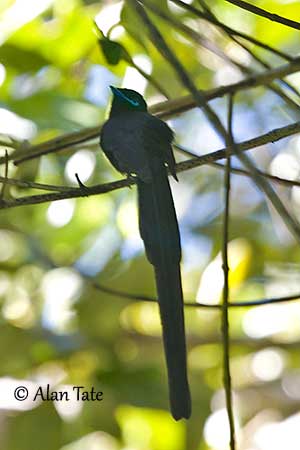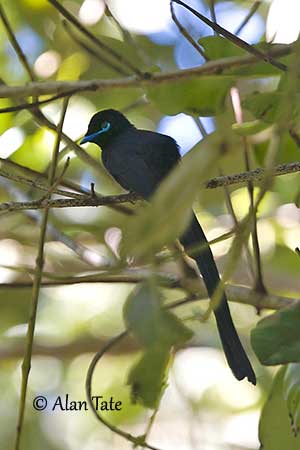
Fr: Tchitrec des Seychelles
Ang: Seychelles Paradise-Flycatcher
All: Seychellenparadiesschnäpper
Esp: Monarca-colilargo de las Seychelles
Ita: Pigliamosche del paradiso delle Seychelles
Nd: Seychellenparadijsmonarch
Sd: seychellparadismonark
Photographers:
Jean Michel Fenerole
Photos d’Oiseaux du monde
Alan & Ann Tate
AA Bird Photography
Text by Nicole Bouglouan
Sources:
HANDBOOK OF THE BIRDS OF THE WORLD Vol 11 by Josep del Hoyo, Andrew Elliott and David Christie - Lynx Edicions - ISBN: 849655306X
Birds of Madagascar and the Indian Ocean Islands Par Roger Safford, Adrian Skerrett, Frank Hawkins – ISBN: 1472924118, 9781472924117- Editeur: Bloomsbury Publishing, 2015
The Birds of Africa: Volume VIII: The Malagasy Region: Madagascar, Seychelles, Comoros, Mascarenes - Par Roger Safford, Frank Hawkins – ISBN: 1408190494, 9781408190494- Editeur: A&C Black, 2013
CREAGUS - MONARCHS Monarchidae
Encyclopaedia Britannica – Monarch bird
Wikipedia, the free encyclopaedia
The Last Refuge of the Seychelles Paradise Flycatcher
Restoring the Seychelles Paradise Flycatcher
AQUA-FIRMA – Water – Wilderness - Wildlife
Seychelles Paradise-Flycatcher
Terpsiphone corvina
Passeriformes Order – Monarchidae Family
INTRODUCTION:
The Seychelles Paradise-Flycatcher is endemic to Seychelles. It is placed in the genus Terpsiphone that includes some of the most spectacular birds of continental Africa and Asia.
This species lives on La Digue from which it is native. On this island, it frequents dense Calophyllum forests, a genus of tropical flowering plant species. It feeds on insects, larvae and spiders caught by gleaning and hawking. It nests in a nice bowl-shaped structure and both parents share the nesting duties.
The Seychelles Paradise-Flycatcher is threatened by habitat loss and fragmentation due to tourism and human settlements on La Digue, and predation by introduced mammals.
The small population has recently stabilised and probably continues to increase. But currently, the Seychelles Paradise-Flycatcher is classified as Critically Endangered.

DESCRIPTION OF THE BIRD:
Biometrics:
Length: Male: 20 cm + tail of 30 cm – Female: 17-20 cm
Weight: 18 gr
The Seychelles Paradise-Flycatcher male has entirely black plumage with blue sheen. The black tail is very long with elongated central rectrices projecting up to 22 centimetres beyond other tail feathers.
The bill is pale blue, with a strip of bare blue facial skin extending to the base. The eyes are brown with pale blue eyering wattle. Legs and feet are grey-blue.
The female differs strongly from the male. She has black head. The upperparts are chestnut-brown, including wings and tail. The underparts are whitish, extending onto the nape to form a narrow pale collar. She lacks the elongated central rectrices. She has no bare facial skin, but eyering wattle and bill are pale blue.
The juvenile resembles female, but it is duller and browner. The bill is blackish with pale lower mandible. Legs and feet are blackish.
RANGE:
The Seychelles Paradise-Flycatcher is found on La Digue, Seychelles. The species has been reintroduced in Denis. There are some reports from Marianne, Félicité and Praslin in Seychelles.
HABITAT:
The Seychelles Paradise-Flycatcher lives in Calophyllum forests, and is native of high-canopy broadleaf woodland with tall trees (at least 17 metres tall), especially on the plateau of La Digue. It is often seen near marshy areas and water bodies.
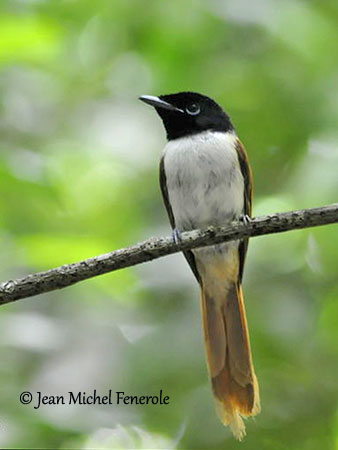
CALLS AND SONGS: SOUNDS BY XENO-CANTO
The vocalisations of Terpsiphone species include whistled songs and frequent harsh calls. The Seychelles Paradise-Flycatcher gives a harsh “zweet” in alarm. We can also hear high, creaky “crikikikerkikerki” and variants. The song is a repeated piping whistle “pli-pli-pli-pli” and a clear warbler “tui… titertitaptiteri” and some variants.
The female is usually less vocal. She may utter a quiet twitter or some subsong.
BEHAVIOUR IN THE WILD:
The Seychelles Paradise-Flycatcher is an insect-eater feeding on a variety of insect species often caught on the wing.
It forages by hawking from a perch, but also by sally-gleaning, hovering and gleaning, and may pursue prey in flight.
These prey include items of 1-2 centimetres long, such as orthopterans, lepidopterans, dipterans, cockroaches, hymenopterans, dragonflies, neuropterans and phasmids. Spiders and larvae are also taken.
The Seychelles Paradise-Flycatcher usually forages in native tree species, between 4 and 8 metres above the ground, but also in other type of vegetation.
The males forage in the lower level whereas the females usually forage higher. They may join mixed-species flocks.
The Seychelles Paradise-Flycatcher is monogamous and territorial during the breeding season. Sometimes, several birds may nest close to each other and defend together the site against predators.
The females may select the males based on their tail length which is a form of sexual selection. We can suggest that the head pattern and the long tail feathers are used in courtship. During the courtship displays, the male often whisks its long rectrices, moving them up and down and sideways. Both adults share the nesting duties.
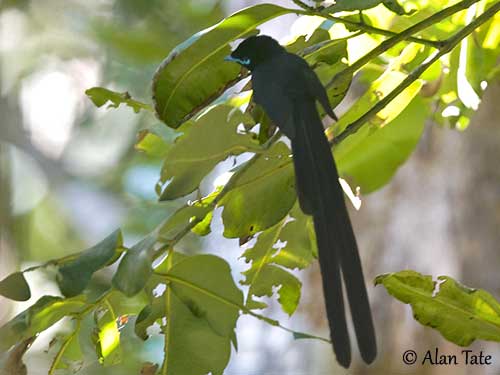
The Seychelles Paradise-Flycatcher is resident and only performs some dispersal to other islands.
It is agile in flight when flying to catch insects in mid-air. It darts between trees in undulating flight and also performs flycatching.
REPRODUCTION OF THIS SPECIES:
The breeding season may extend throughout the year, with peak during the wettest period in November/April.
Both adults build the nest, a cup made with palm fibres and needles of Casuarina plant, held together with spider web. The cup is lined with soft grass. There is often a “dangling tail” of untidy material below the cup. The nest is placed on a branch or twig, often in a fork and usually 3-5 metres above the ground.
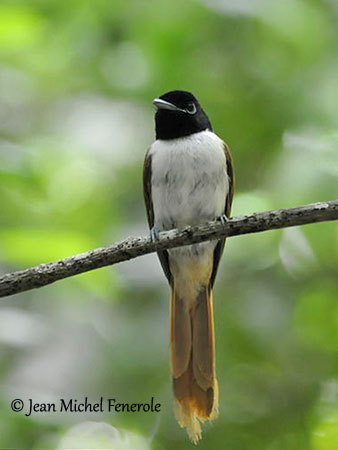
The female lays a single whitish egg with darker spots. Both adults incubate (mainly the female) during 17 days. The young is fed by its parents, and still depends on them for up to two months after fledging.
The nest predators include rats and reptiles, and probably some birds too.
PROTECTION / THREATS / STATUS:
The Seychelles Paradise-Flycatcher is threatened by human disturbance, habitat loss and fragmentation on La Digue where woodland clearance is increasing. Nest predation is highest at forest edge, as a result of this fragmentation.
The population is roughly estimated to number 140/190 mature individuals. It appears to have stabilised at 150/200 individuals, and will continue to increase.
But currently, the Seychelles Paradise-Flycatcher is listed as Critically Endangered.
